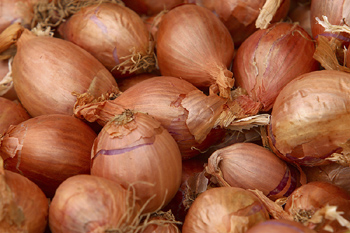How to Grow Onions
Learning how to grow onions is one of the best ways to allocate your garden resources, because onions are used in so many recipes and dishes. You may be like me and not like raw onions in the least, but even then, cooked onions are useful in enhancing the taste in foods ranging from Italian pasta dishes to Indian curries.
If you want to enjoy the freshest onions, grow them fresh in your own in personal garden, or even on an indoor vine. Homegrown onions aren’t hard to upkeep and should be fresher and higher quality than those bought at the store. You’ll also be secure, knowing that no harmful pesticides went into the production of your crop, and therefore trace amounts of pesticides don’t end up being consumed by you and your family.
Besides that, growing your own food helps you feel fulfilled and rewarded and closer to the soil. Once you’ve learned how to grow onions, you can nurture a living entity through its natural life cycle and live in symbiosis with your property, by eating what you grow on your own land.
Why Write About Onions?
This article details all you need to know about onions and the processes used in planting onions, growing and harvesting this bulbous vegetable. I’ll give you a list of the materials and tools you need to start your onion project, along with general information about onion plants. Then I’ll list the steps necessary to the actual process of growing onions from seeds or onion part, and the planting stage all the way to harvest.
Finally, I’ll offer brief onion tips, to guide you through the process.
Learning about Onion Growth
Onions are confused with tuber plants, because the vine they grow on produces a bulbous fruit submerged in the ground for a food source. However, onions are just another form of vegetable and this bulbous fruit is the part that you cut up and eat in your foods. Onions aren’t considered official fruit, because they don’t bear seeds, which is one thing that distinguishes fruit from vegetables.
Onions are a global food. You’ll find different onions all over the world, where they find their way into food dishes in every known culture.
Onions are hardy little plants and don’t require a lot of special care, which probably accounts for their widespread dissemination. Onions thrive in environments that other plants might wither and die in. However, you’ll need to gather a few things to start your onion project.

How to Grow Onions
Grow onions outdoors in a personal garden, since the fruit part you harvest grows deep in the ground compared to other, smaller plants. Onions have a vertical growth vine you must account for. However, it’s possible to grow onions in a controlled indoor environment, if you live in an inhospitable environment or if the seasons are against you.
Regardless of where you grow your onions, you’re going to need the following.
- Spade
- Seeds or existing onion plants
- Watering can
- Soil
- Manure or soil enhancing product
- Pot or plant container for indoor growth
Onion Growth Technique
Onions grow best when you start with an existing onion plant, though seeds also work, in a pinch. Seeds might be easy to come by and cheap, but they take 8 to 10 weeks longer to grow than an existing plant part.
Either way, the process is much the same. Whether you choose to plant your onion plant indoors or outside in your garden, you want an area of soil to plant that gets about 6 hours of sunlight each and every day.
Growing Onions
The soil mixture should be moderate; try 1 part soil enhancement or fertilizer for every 3 parts soil. Onions low maintenance plants, though you have to watch out for maggots and worms, which are their primary enemies.
You can insure your onion crop by adding nematodes to your soil, which eat these onion predators. Once your soil base is ready, you’re primed for planting onions.
Soil for Onions
Till the soil and dig at least 8 inches down with your spade, before you place the seeds or onion parts into the soil. Cover the embryonic plant with soil and lightly water the whole thing. You want to nurture your plants by providing roughly an inch of water every week – no more and no less.
When the plants begin to grow and the bulbs peek out of the soil, add more soil and enhancement mix to cover it back up again, allowing for further development. Harvest your crop when the tops of the onion vine are about 6 inches tall.
Keep in mind, however, that the bigger the onion bulb grows, the stronger the taste is when you eventually harvest it. This might be desirable for those who like a particularly bold onion taste, though many prefer to harvest more moderate tasting onions when considering how to grow onions.
